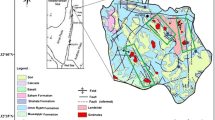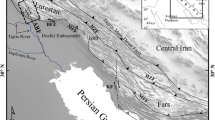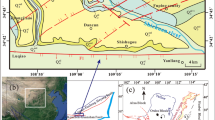Abstract
Xi’an ground fractures are the most typical ground fractures in China. Fourteen fractures have nearly divided the historical city into several distinct sections. These fractures are parallel and distributed in NEE direction at the same interval, with all features exhibiting a down dropping southerly block which extends to connect with the underlying fault. The activities of fractures are primarily expressed as normal faults. The faulted strata are well defined and dislocation displacement increases with depth. Thus, fractures have the characteristics of syn-sedimentary faults, which constitute the hanging wall of the Lintong-Chang’an fault branch system. Crustal thinning caused by the uplifting of upper mantle provides a power source for extension and stretching along the fracture surface of the upper crust, which results in a series of extensional faults and the suitable conditions for forming massive ground fractures. The movement of tectonic blocks influences the normal dip-slipping tension of Lintong-Chang’an fault branches, and produces a series of secondary tectonic fractures adjacent to surface, which constitute the prototype of ground fractures. The recent regional tensile stress produced by modern mainland deformation, also profoundly influences the current activity of Xi’an ground fractures.
Similar content being viewed by others
References Cited
Altamimi, Z., Collilieux, X., Legrand, J., et al., 2007. ITRF2005: A New Release of the International Terrestrial Reference Frame Based on Time Series of Station Positions and Earth Orientation Parameters. Journal of Geophysical Research, 112(B9): B9401. https://doi.org/10.1029/2007jb004949
Burbey, T. J., 2010. Mechanisms for Earth Fissure Formation in Heavily Pumped Basins. Land Subsidence, Associated Hazards and the Role of Natural Resources Development. IAHS-AISH Publication, 339: 3–8
Chen, Z. X., Yuan, Z. H., Peng, J. B., 2007. Basin Characteristics about Ground Fractures Development of Weihe Basin. Journal of Engineering Geology, 15: 441–447 (in Chinese with English Abstract)
De Filippis, L., Anzalone, E., Billi, A., et al., 2013. The Origin and Growth of a Recently-Active Fissure Ridge Travertine over a Seismic Fault, Tivoli, Italy. Geomorphology, 195: 13–26. https://doi.org/10.1016/j.geomorph.2013.04.019
El Baruni, S. S., 1994. Earth Fissures Caused by Groundwater Withdrawal in Sarir South Agricultural Project Area, Libya. Hydrogeology Journal, 2(1): 45–52. https://doi.org/10.1007/s100400050045
Feng, X. J., 2000. Gushui Fault Profile on the Weihe Fault. Seismology and Geology, 22(2): 209–230 (in Chinese)
Gudmundsson, A., 2011. Rock Fractures in Geological Processes. Cambridge University Press, Cambridge
Herring, T. A., 2002. GLOBK: Global Kalman Filter VLBI and GPS Analysis Program, Version 10.0. Massachusetts Institute of Technology. (2002-3-25) [2018-3-20]. http://chandler.mit.edu/~simon/gtgk/GLOBK.pdf
Hu, X. L., Tang, H. M., Li, C. D., et al., 2012. Stability of Huangtupo Riverside Slumping Mass II# under Water Level Fluctuation of Three Gorges Reservoir. Journal of Earth Science, 23(3): 326–334. https://doi.org/10.1007/s12583-012-0259-0
Jiang, W. L., Xiao, Z. M., Xie, X. S., 2000. Segmentations of Active Normal Dip-Slip Faults around Ordos Block According to Their Surface Ruptures in Historical Strong Earthquakes. Acta Seismologica Sinica, 13(5): 552–562. https://doi.org/10.1007/s11589-000-0055-2
King, R. W., Bock, Y., 2000. Documentation for the GAMIT GPS Analysis Software, Release 10.0. Department of Earth, Atmospheric, and Planetary Sciences Massachusetts Institute of Technology, Scripps Institution of Oceanography University of California at San Diego. [2018-3-20]. http://www-gpsg.mit.edu/~simon/gtgk/GAMIT.pdf
Larsen, B., Grunnaleite, I., Gudmundsson, A., 2010. How Fracture Systems Affect Permeability Development in Shallow-Water Carbonate Rocks: An Example from the Gargano Peninsula, Italy. Journal of Structural Geology, 32(9): 1212–1230. https://doi.org/10.1016/j.jsg.2009.05.009
Lee, C. F., Zhang, J. M., Zhang, Y. X., 1996. Evolution and Origin of the Ground Fissures in Xi’an, China. Engineering Geology, 43(1): 45–55. https://doi.org/10.1016/0013-7952(95)00088-7
Li, P., Zhou, S. Y., Chen, Y. S., et al., 2010. 3D Velocity Structure in Shanxi Graben and Erdos from Two Plane Waves Method. Computerized Tomography Theory and Applications, 19(3): 47–60 (in Chinese)
Li, Y. L., Yang, J. C., Hu, X. M., 2000. Origin of Ground Fissures in the Shanxi Graben System, Northern China. Engineering Geology, 55(4): 267–275. https://doi.org/10.1016/s0013-7952(99)00082-4
Li, Z. H., Feng, W. P., Xu, Z. H., et al., 2008. The 1998Mw 5.7 Zhangbei-Shangyi (China) Earthquake Revisited: A Buried Thrust Fault Revealed with Interferometric Synthetic Aperture Radar. Geochemistry, Geophysics, Geosystems, 9(4). https://doi.org/10.1029/2007gc001910
Liu, C. G., Li, G. R., Wang, D. W., et al., 2016. Middle–Upper Ordovician (Darriwilian–Early Katian) Positive Carbon Isotope Excursions in the Northern Tarim Basin, Northwest China: Implications for Stratigraphic Correlation and Paleoclimate. Journal of Earth Science, 27(2): 317–328. https://doi.org/10.1007/s12583-016-0696-2
Lü, Y., Peng, J. B., Wang, G. L., 2014. Characteristics and Genetic Mechanism of the Cuihua Rock Avalanche Triggered by a Paleo-Earthquake in Northwest China. Engineering Geology, 182: 88–96. https://doi.org/10.1016/j.enggeo.2014.08.017
Myers, J. R., Gomez, F. G., 2010. Analysis of Subsidence and Ground Fissuring in the Fenwei Basin (Northern China) Using Radar Interferometry. AGU Fall Meeting Abstracts #H23F-1297. December 2010, San Francisco
Peng, J. B., Chen, L. W., Huang, Q. B., et al., 2008. Large-Scale Physical Simulative Experiment on Ground-Fissure Expansion Mechanism. Chinese J. Geophys., 6: 1826–1834 (in Chinese with English Abstract)
Peng, J. B., Chen, L. W., Huang, Q. B., et al., 2013. Physical Simulation of Ground Fissures Triggered by Underground Fault Activity. Engineering Geology, 155: 19–30. https://doi.org/10.13039/501100001809
Peng, J. B., Fan, W., Li, X. A., et al., 2007. Some Key Question in the Formation of Ground Fissures in the Fen-Wei Basin. Journal of Engineering Geology, 15(4): 433–440 (in Chinese with English Abstract)
Peng, J. B., Sun, P., Li, X., 2006. Ground Fissure: The Major Geological and Environmental Problem in the Development of Xi’an City, China. Environmental Science and Technology, American Science Press, [S.l.]. 469–474
Qu, W., Lu, Z., Zhang, Q., et al., 2014. Kinematic Model of Crustal Deformation of Fenwei Basin, China Based on GPS Observations. Journal of Geodynamics, 75: 1–8. https://doi.org/10.1016/j.jog.2014.01.001
Qu, W., Wang, Y. S., Zhang, Q., et al., 2016. Current Crustal Deformation Variation Characteristics of the Fenwei Baisn and Its Surrounding Areas Revealed by GPS Data. Chinese J. Geophys., 59(3): 828–839 (in Chinese with English Abstract)
Ren, J., Feng, X. J., Wang, F. Y., 2013. Revealed the Fine Crust Structures of Xi’an Sag in Weihe Basin by Deep Seismic Reflection Profile. Chinese J. Geophys., 56(2): 513–521 (in Chinese with English Abstract)
Ren, J., Peng, J. B., Wang, F. X., et al., 2012. The Research of Deep Structural Features of Weihe Basin and Adjacent Areas. Chinese J. Geophys., 55(9): 2939–2947 (in Chinese with English Abstract)
Song, Y. G., An, Z. S., 2010. Correlation of Paleoclimatic Records between Chinese Eolian Sediments and Baikal Lacustrine Sediments. Journal of Earth Science, 21(S1): 260–264. https://doi.org/10.1007/s12583-010-0230-x
Yang, M. H., Li, L., Zhou, J., et al., 2013. Segmentation and Inversion of the Hangjinqi Fault Zone, the Northern Ordos Basin (North China). Journal of Asian Earth Sciences, 70/71: 64–78. https://doi.org/10.1016/j.jseaes.2013.03.004
Zeng, F. M., Xiang, S. Y., 2017. Geochronology and Mineral Composition of the Pleistocene Sediments in Xitaijinair Salt Lake Region, Qaidam Basin: Preliminary Results. Journal of Earth Science, 28(4): 622–627. https://doi.org/10.1007/s12583-016-0712-6
Zhang, J. M., 1990. Research on Ground Fracturing in the Region of Xi’an. Northwest University Press, Xi’an (in Chinese)
Zhang, Q., Qu, W., Wang, Q. L., et al., 2011. Analysis of Present Tectonic Stress and Regional Ground Fissure Formation Mechanism of the Weihe Basin. Survey Review, 43(322): 382–389. https://doi.org/10.1179/003962611x13055561708740
Zhang, S. Q., Wu, L. J., Guo, J. M., 1985. An Interpretation of the DSS Data on Menyuan-Pingliang-Weinan Profile in West China. Chinese J. Geophys., 28(5): 460–472 (in Chinese)
Acknowledgments
This study was supported by the National Key Basic Research Project of China (No. 2014CB744703), the National Natural Science Foundation of China (Nos. 41790445, 41731066, 41674001, 41202189, 41274004, 41274005), the Natural Science Basic Research Plan of Shaanxi Province, China (No. 2016JM4005), the Special Fund for Basic Scientific Research of Central Universities (Nos. CHD300102268204, CHD2014G1261050, CHD2014G3263014), and the China Postdoctoral Science Foundation (No. 2013M530412). The final publication is available at Springer via https://doi.org/10.1007/s12583-018-0841-1.
Author information
Authors and Affiliations
Corresponding author
Rights and permissions
About this article
Cite this article
Peng, J., Qu, W., Ren, J. et al. Geological Factors for the Formation of Xi’an Ground Fractures. J. Earth Sci. 29, 468–478 (2018). https://doi.org/10.1007/s12583-018-0841-1
Received:
Accepted:
Published:
Issue Date:
DOI: https://doi.org/10.1007/s12583-018-0841-1




